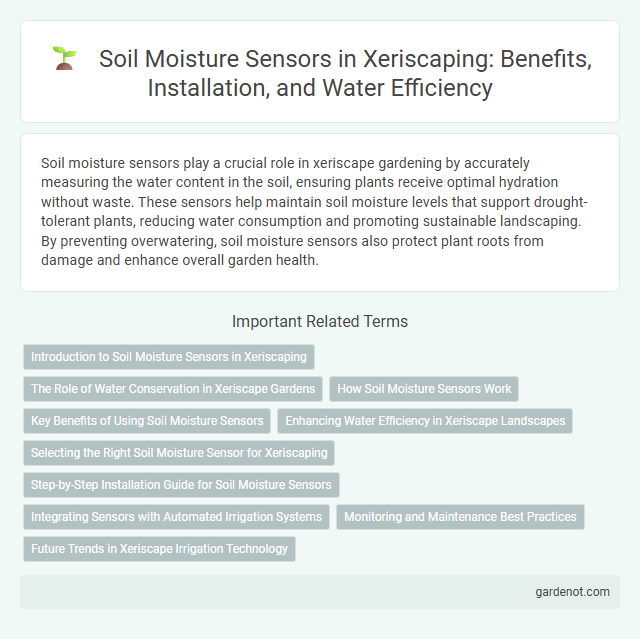Soil moisture sensors play a crucial role in xeriscape gardening by accurately measuring the water content in the soil, ensuring plants receive optimal hydration without waste. These sensors help maintain soil moisture levels that support drought-tolerant plants, reducing water consumption and promoting sustainable landscaping. By preventing overwatering, soil moisture sensors also protect plant roots from damage and enhance overall garden health.
Introduction to Soil Moisture Sensors in Xeriscaping
Soil moisture sensors play a vital role in xeriscaping by accurately measuring the water content in soil, ensuring plants receive optimal hydration without waste. These sensors help maintain efficient irrigation schedules, promoting water conservation in drought-prone landscapes. Integrating soil moisture sensors reduces overwatering, supports plant health, and aligns with sustainable xeriscape garden practices.
The Role of Water Conservation in Xeriscape Gardens
Soil moisture sensors play a crucial role in water conservation within xeriscape gardens by providing accurate data on soil hydration levels, preventing overwatering and reducing water waste. These sensors enable precise irrigation scheduling, ensuring plants receive only the necessary amount of water to thrive in arid environments. Integrating soil moisture sensors with automated irrigation systems enhances xeriscape efficiency, promoting sustainable water management and improving plant health.
How Soil Moisture Sensors Work
Soil moisture sensors measure the volumetric water content in soil by detecting the dielectric permittivity, which varies with moisture levels, providing precise irrigation data essential for xeriscape landscaping. These sensors use electrical resistance, capacitance, or time-domain reflectometry (TDR) to determine soil moisture, optimizing water use by signaling when irrigation is necessary. Integrating soil moisture sensors in xeriscape design reduces water waste, promotes plant health, and supports sustainable water management.
Key Benefits of Using Soil Moisture Sensors
Soil moisture sensors optimize water usage by accurately measuring the water content in the soil, preventing overwatering and conserving valuable resources. They enhance plant health and growth by ensuring precise irrigation schedules tailored to xeriscape landscapes, reducing water stress and promoting drought resistance. Implementing soil moisture sensors leads to cost savings on water bills and minimizes environmental impact through efficient water management.
Enhancing Water Efficiency in Xeriscape Landscapes
Soil moisture sensors significantly enhance water efficiency in xeriscape landscapes by providing precise data on soil hydration levels, enabling targeted irrigation only when necessary. Utilizing real-time moisture readings prevents overwatering and conserves water resources, aligning with xeriscape principles of drought tolerance and sustainability. Integrating advanced soil moisture sensors with automated irrigation systems optimizes plant health and reduces water waste in arid environments.
Selecting the Right Soil Moisture Sensor for Xeriscaping
Selecting the right soil moisture sensor for xeriscaping involves choosing a device with high accuracy and compatibility with sandy or rocky soils common in drought-tolerant landscapes. Sensors using capacitance or dielectric technology provide precise measurements of volumetric water content, essential for optimizing irrigation in xeriscape gardens. Prioritize sensors with easy integration to smart irrigation systems for efficient water management and sustainable plant health.
Step-by-Step Installation Guide for Soil Moisture Sensors
Begin the soil moisture sensor installation by selecting a representative planting area free from surface debris and compacted soil. Insert the sensor probe vertically into the soil at root zone depth, typically 6 to 12 inches, ensuring firm contact with the surrounding soil to achieve accurate moisture readings. Connect the sensor to a compatible irrigation controller or data logger, calibrating the device according to manufacturer instructions to optimize water efficiency in xeriscape landscapes.
Integrating Sensors with Automated Irrigation Systems
Integrating soil moisture sensors with automated irrigation systems enhances water efficiency by delivering precise irrigation based on real-time soil moisture data. These sensors detect the exact moisture levels in xeriscape landscapes, preventing overwatering and promoting optimal plant health. Automated systems adjust watering schedules dynamically, reducing water waste while maintaining sustainable landscaping practices.
Monitoring and Maintenance Best Practices
Soil moisture sensors play a crucial role in xeriscape irrigation by providing precise real-time data on soil water content, allowing for efficient water use and preventing overwatering. Regular calibration and cleaning of sensors ensure accurate readings and prolong sensor lifespan, while strategic sensor placement across varied soil zones captures representative moisture levels. Integrating sensor data with automated irrigation systems enables dynamic adjustment of watering schedules, promoting optimal plant health and conserving water resources.
Future Trends in Xeriscape Irrigation Technology
Soil moisture sensors are revolutionizing xeriscape irrigation by enabling precise water delivery based on real-time soil hydration levels, significantly reducing water waste. Future trends highlight advancements in wireless sensor networks and AI-driven analytics, allowing for predictive irrigation scheduling that adapts to plant needs and weather conditions. Integration with smart home systems and solar-powered sensors will further enhance sustainability and operational efficiency in xeriscape landscapes.
Soil moisture sensor Infographic

 gardenot.com
gardenot.com